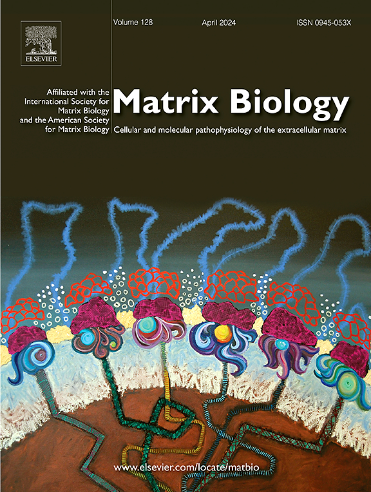Loss of MMP9 disturbs cranial suture fusion via suppressing cell proliferation, chondrogenesis and osteogenesis in mice
IF 4.8
1区 生物学
Q1 BIOCHEMISTRY & MOLECULAR BIOLOGY
引用次数: 0
Abstract
Cranial sutures function as growth centers for calvarial bones. Abnormal suture closure will cause permanent cranium deformities. MMP9 is a member of the gelatinases that degrades components of the extracellular matrix. MMP9 has been reported to regulate bone development and remodeling. However, the function of MMP9 in cranial suture development is still unknown. Here, we identified that the expression of Mmp9 was specifically elevated during fusion of posterior frontal (PF) suture compared with other patent sutures in mice. Interestingly, inhibition of MMP9 ex vivo or knockout of Mmp9 in mice (Mmp9-/-) disturbed the fusion of PF suture. Histological analysis showed that knockout of Mmp9 resulted in wider distance between osteogenic fronts, suppressed cell condensation and endocranial bone formation in PF suture. Proliferation, chondrogenesis and osteogenesis of suture cells were decreased in Mmp9-/- mice, leading to the PF suture defects. Moreover, transcriptome analysis of PF suture revealed upregulated ribosome biogenesis and downregulated IGF signaling associated with abnormal closure of PF suture in Mmp9-/- mice. Inhibition of the ribosome biogenesis partially rescued PF suture defects caused by Mmp9 knockout. Altogether, these results indicate that MMP9 is critical for the fusion of cranial sutures, thus suggesting MMP9 as a potential therapeutic target for cranial suture diseases.
MMP9 的缺失会抑制小鼠的细胞增殖、软骨生成和骨生成,从而干扰颅缝融合。
颅缝是颅骨的生长中心。缝合异常会导致永久性颅骨畸形。MMP9 是明胶酶的一种,可降解细胞外基质的成分。据报道,MMP9 可调节骨骼的发育和重塑。然而,MMP9在颅缝发育中的功能尚不清楚。在这里,我们发现在小鼠额后缝(PF)融合过程中,Mmp9的表达较其他专利缝特异性升高。有趣的是,体内抑制 Mmp9 或在小鼠体内敲除 Mmp9(Mmp9-/-)会干扰 PF 缝的融合。组织学分析表明,敲除 Mmp9 会导致成骨前沿之间的距离变宽,抑制 PF 缝的细胞凝聚和颅内骨形成。Mmp9-/-小鼠缝合细胞的增殖、软骨生成和成骨能力下降,导致PF缝合缺损。此外,PF缝的转录组分析显示,核糖体生物发生上调和IGF信号下调与Mmp9-/-小鼠PF缝的异常闭合有关。抑制核糖体生物发生可部分修复 Mmp9 基因敲除导致的 PF 缝缺陷。总之,这些结果表明,MMP9对于颅缝融合至关重要,从而提示MMP9是颅缝疾病的潜在治疗靶点。
本文章由计算机程序翻译,如有差异,请以英文原文为准。
求助全文
约1分钟内获得全文
求助全文
来源期刊

Matrix Biology
生物-生化与分子生物学
CiteScore
11.40
自引率
4.30%
发文量
77
审稿时长
45 days
期刊介绍:
Matrix Biology (established in 1980 as Collagen and Related Research) is a cutting-edge journal that is devoted to publishing the latest results in matrix biology research. We welcome articles that reside at the nexus of understanding the cellular and molecular pathophysiology of the extracellular matrix. Matrix Biology focusses on solving elusive questions, opening new avenues of thought and discovery, and challenging longstanding biological paradigms.
 求助内容:
求助内容: 应助结果提醒方式:
应助结果提醒方式:


